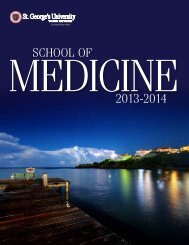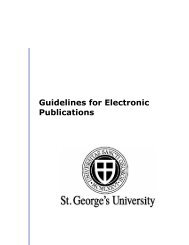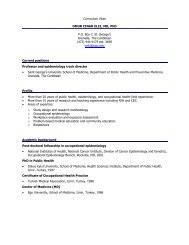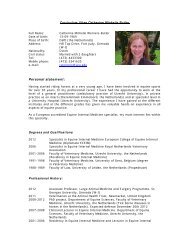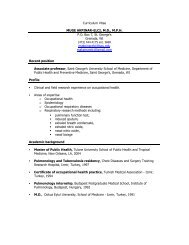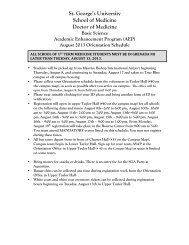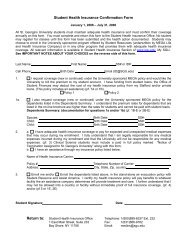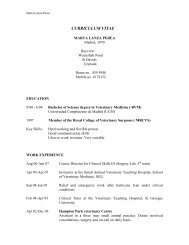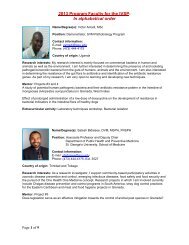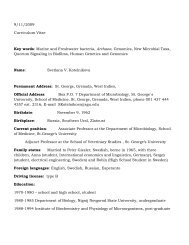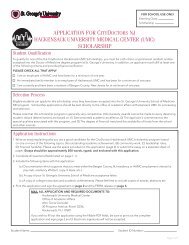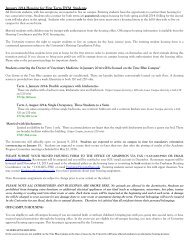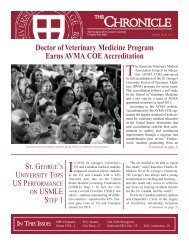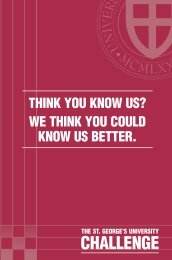SVM Catalogue 2012-2013 - St. George's University
SVM Catalogue 2012-2013 - St. George's University
SVM Catalogue 2012-2013 - St. George's University
Create successful ePaper yourself
Turn your PDF publications into a flip-book with our unique Google optimized e-Paper software.
Course Descriptions<br />
Preveterinary medical<br />
Program<br />
BIOL 220/BIOL 221<br />
General Biology/Human Biology<br />
General Biology and Human Biology are specifically<br />
for students in the preprofessional programs. These<br />
courses aim to explain the role of macromolecules in the<br />
organization of cells and the compartmentalization of<br />
metabolic reactions, as well as the role of the cell cycle with<br />
regard to inheritance.<br />
BIOL 303<br />
Biomedical Anatomy<br />
<strong>St</strong>udents will learn the anatomical position, anatomical<br />
terms, anatomical planes, and anatomical regions<br />
pertaining to the dog.<br />
BIOL 320<br />
Genetics<br />
This course is designed to introduce undergraduate<br />
students in the preprofessional programs to the principles<br />
of classical, molecular, and population genetics. It will<br />
summarize one of the most dynamic and productive areas<br />
of modern biology by providing a historical background of<br />
our knowledge of heredity and a review of advances in our<br />
knowledge of gene structure and function. <strong>St</strong>udents are<br />
expected to develop problem-solving skills in the course<br />
of their study. Testing will emphasize the use of problembased<br />
questions in which students must apply principles<br />
learned in lecture to novel situations. The application of<br />
genetic principles to medicine (human and veterinary) will<br />
be emphasized throughout the course.<br />
BIOL 321/BIOL 331<br />
Molecular Biology/Molecular Biology Laboratory<br />
This course is designed to help students to develop an<br />
understanding of the molecular mechanisms that biological<br />
organisms use to store and preserve genetic information,<br />
the means by which they use that information to create<br />
functional biological structures, and the techniques that are<br />
commonly used to manipulate and study these processes<br />
in the laboratory. A basic understanding of chemistry,<br />
biology, and biochemistry will be assumed. The goal of<br />
the accompanying laboratory sessions is to help students<br />
develop an understanding of the study of molecular<br />
biology in the laboratory, develop an understanding of<br />
the technical limitations and potential errors that can be<br />
encountered in the laboratory, develop an understanding<br />
of the scientific method and the source of the facts studied<br />
in lecture, and develop the ability to interpret, organize,<br />
and present scientific information.<br />
BIOL 401<br />
Microbiology<br />
This course attempts to provide a general introduction into<br />
the microbial world with information on microbial physiology,<br />
growth and its control, nutrition, interactions within various<br />
ecosystems, biotechnology, and industrial aspects.<br />
BIOL 441<br />
Physiology<br />
This course is designed to provide a fundamental basis for<br />
understanding mammalian physiology. Physiology is useful<br />
for students in the premedical program, preveterinary<br />
medical program, nursing program, and allied health<br />
curriculums.<br />
CHeM 122/CHeM 123<br />
General Chemistry I/General Chemistry I Laboratory<br />
A one-semester course in general chemistry for students<br />
in science-related majors and the premedical program.<br />
The course will introduce basic concepts in physical and<br />
inorganic chemistry.<br />
CHeM 124/CHeM 125<br />
General Chemistry II/General Chemistry II Laboratory<br />
General Chemistry II covers topics in kinetics, equilibrium,<br />
acid-base, thermodynamics, electrochemistry, metallurgy,<br />
nonmetals, nuclear chemistry, transition elements, and<br />
organic chemistry.<br />
CHeM 222/CHeM 223<br />
Organic Chemistry I/Organic Chemistry I Laboratory<br />
Organic Chemistry I covers topics including nomenclature<br />
and classification of organic molecules, structure, and<br />
reactivity of functional groups (hydrocarbons, alcohols,<br />
alkyl halides, alkadienes, and allylic systems).<br />
School of Medicine<br />
Course Descriptions<br />
School of Veterinary Medicine Catalog <strong>2013</strong>–2014 | 43



